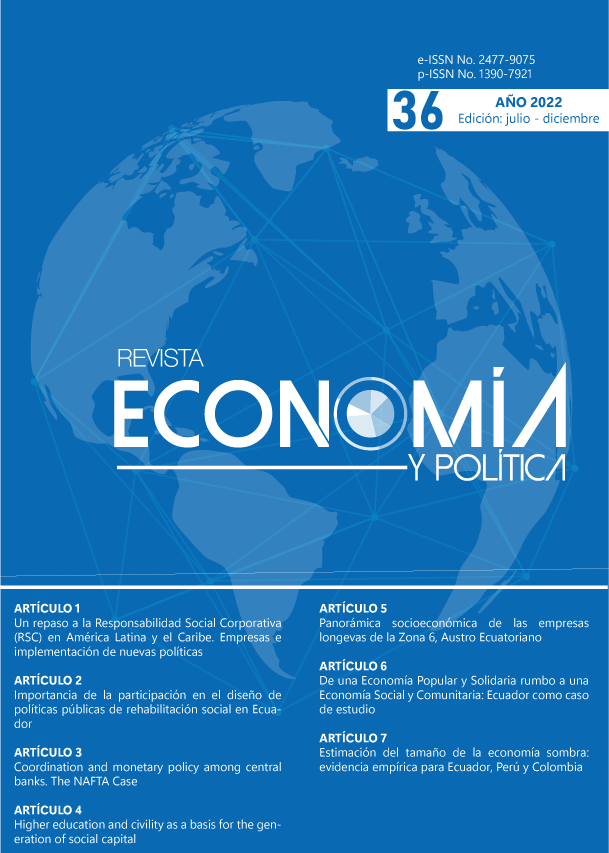Coordination and monetary policy among central banks. The NAFTA Case
DOI:
https://doi.org/10.25097/rep.n36.2022.03Palabras clave:
Coordinación entre bancos centrales, política monetaria, estabilidad monetaria-financieraResumen
En el presente trabajo se demostró cómo los bancos centrales que integran el TLCAN (Canadá, Estados Unidos de América y México), se coordinan alrededor del país líder a fin de mantener la estabilidad y el buen funcionamiento de los mercados financieros. Para ello se estimó un modelo VAR con el objetivo de mostrar la interdependencia entre las tasas de interés de política monetaria. De acuerdo con los resultados obtenidos, se encontró evidencia de que las tasas de interés de Canadá y México se encuentran determinadas en mayor medida por las decisiones monetarias de la Reserva Federal y en menor grado por las condiciones internas. Confirmando con ello que la interdependencia entre los países que integran el TLCAN gira en torno a la economía líder.
Descargas
Citas
Bernanke, B. (2007, may). The subprime mortgage market, At the 43ª Conference annual bank structure and competition, FRB of Chicago, Illinois, USA.
_____, (2013a). The Federal Reserve and the Financial Crisis, New Jersey: Princeton University Press.
_____, (2013b, may). A century of U.S. central banking: Goals, Frameworks, Accountability, At the The First 100 Years of the Federal Reserve: The Policy Record, Lessons Learned, and Prospects for the Future, a conference sponsored by the National Bureau of Economic Research, Cambridge, Massachusetts.
Calberg, M. (2005). International monetary policy coordination, CeGE-Discussion Paper 41, Center for Globalization and Europeanization of the Economy. http://hdl.handle.net/10419/22168
Carlozzi, N. and Taylor, J. (1983). International capital mobility and the coordination of monetary rules, Working Paper 1242, NBER, december. https://ssrn.com/abstract=321297
Chang, H. J. (2002). Kicking away the ladder. Development strategy in historical perspective, London: Wimbledon Publishing Company-Anthem Press.
Clarida, R. (2019), The global factor in neutral policy rates: Some implications for exchange rates, monetary policy, and policy coordination, International Finance, 22(1), 2-19. https://doi.org/10.1111/infi.12345
Contreras, H. (2009). Estados Unidos: la política monetaria ante la crisis, 2008-2009, Economía Informa, 358, 8-23.
Eichengreen, B. (1999). Toward a new international financial architecture: A practical post-Asia agenda, Berkeley: Peterson Institute Press.
Engel, C. (2016). International coordination of central bank policy, Journal of International Money and Finance, 67, 13-24. https://doi.org/10.1016/j.jimonfin.2015.06.009
Fernandez-Albertos, J. (2015). The politics of central bank independence, Annual Review of Political Science, 18, 217-237. https://doi.org/10.1146/annurev-polisci-071112-221121
Greenspan, A. (2010). The crisis, Brookings Papers on Economy Activity, 41(1), spring, 201-261. https://www.brookings.edu/wp-content/uploads/2010/03/2010a_bpea_greenspan.pdf
Mohan, R. and Kapur, M. (2014). Monetary policy coordination and the role of central banks, IMF Working Paper 14-70, International Monetary Fund. http://dx.doi.org/10.5089/9781484362518.001
Meyer, L., Doyle, B., Gagnon, J. and Henderson, D. (2002). International coordination of macroeconomic policies: Still alive in the new millennium?, FRB International Finance Discussion Paper, 723, april. http://dx.doi.org/10.2139/ssrn.307424
Moutot, P. and Vitale, G. (2001). Monetary policy and co-ordination in a globalised world, Revue économique, 52(2), 337-351. https://doi.org/10.3917/reco.522.0337
Moutot, P., Jung, A. and Mongelli, F. P. (2008). The working of the Eurosystem: Monetary policy preparations and decision-making, selected issues, ECB Occasional Paper, 79, january. http://ssrn.com/abstract_id=1005946.
Powell J. (2018). Monetary policy influences on global financial conditions and international capital flows, At Challenges for Monetary Policy and the GFSN in an Evolving Global Economy, Eighth High-Level Conference on the International Monetary System sponsored by the International Monetary Fund and Swiss National Bank, Zurich, Switzerland
Poutineau, J. and Vermandel, G. (2018), International monetary policy coordination in a new Keynesian model with NICE features, The Journal of Economic Education, 49(2), 151-166. https://doi.org/10.1080/00220485.2018.1438945
Rey, H. (2016). International channels of transmission of monetary policy and the Mundellian Trilemma, IMF Economic Review, 64(1), 6-35. https://doi.org/10.1057/imfer.2016.4
Rogoff, K. (1985). Can international monetary cooperation be counterproductive?, Journal of International Economics, 18, may, 199-217. https://doi.org/10.1016/0022-1996(85)90052-2
_____, (1999). International institutions for reducing global financial instability, Journal of Economic Perspectives, 13(4), fall, 21-42. DOI: 10.1257/jep.13.4.21
Salinas, C. (2017). Aliados y adversarios. TLCAN 1988-2017, México: Debate.
Sims, C. (1986). Are forecasting model usable for policy analysis?, The Quarterly Review, FRB of Minneapolis, 10(1), 2-16.
Shiller, R. (2015). Irrational Exuberance, New Jersey: Princeton University Press.
Smets, F. (2014). Financial stability and monetary policy: How closely interlinked? International Journal of Central Banking, 10(2), 263-300. https://www.ijcb.org/journal/ijcb14q2a11.pdf
Taylor, J. (1985). International coordination in the design of macroeconomic policy rules, Economic European Review, 28(1-2), 53-81. https://doi.org/10.1016/0014-2921(85)90014-5
_____, (2013), International monetary policy coordination: past, present, and future, BIS Working Papers, 437. https://ssrn.com/abstract=2384452
Wash, C. (2017). Monetary theory and policy, (4th ed.), Cambridge Ma: The MIT Press.
Publicado
Cómo citar
Número
Sección
Licencia
Derechos de autor 2022 Revista Economía y Política

Esta obra está bajo una licencia internacional Creative Commons Atribución-NoComercial-CompartirIgual 4.0.






